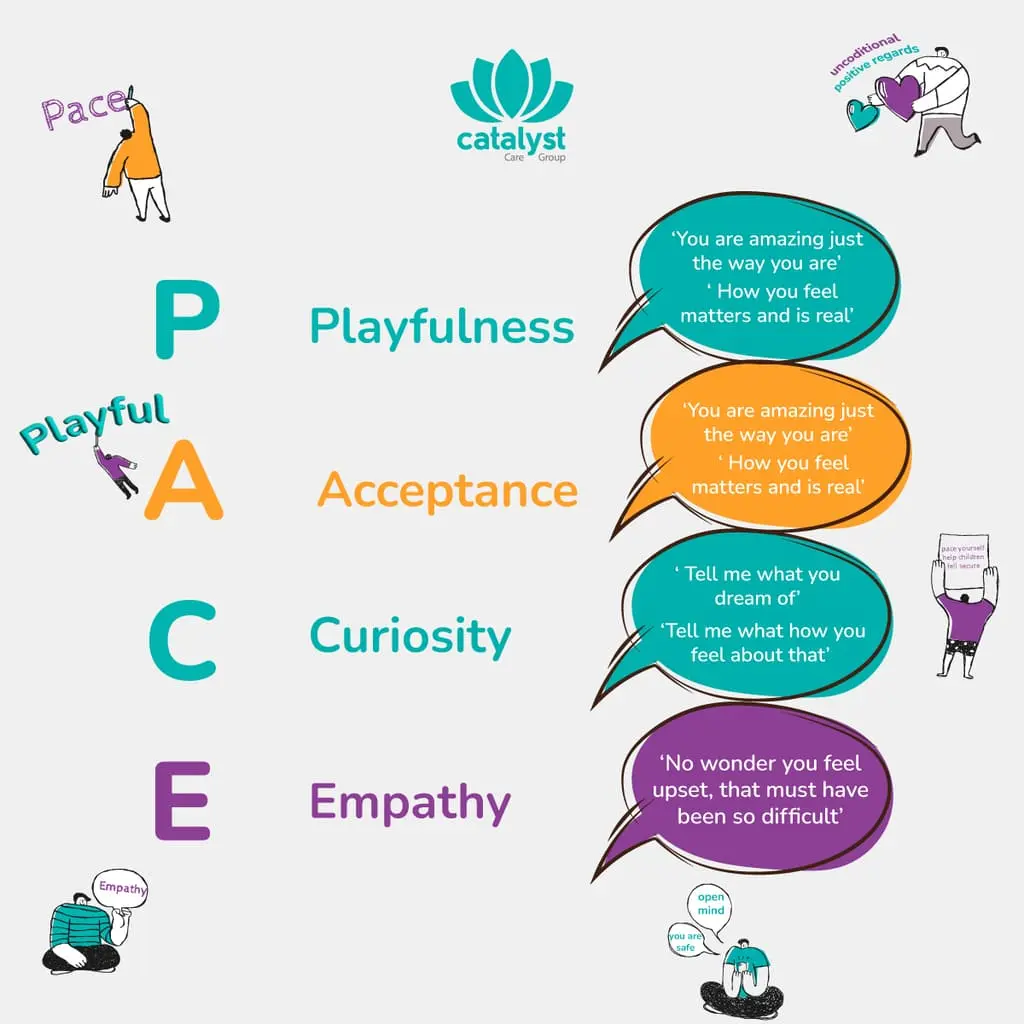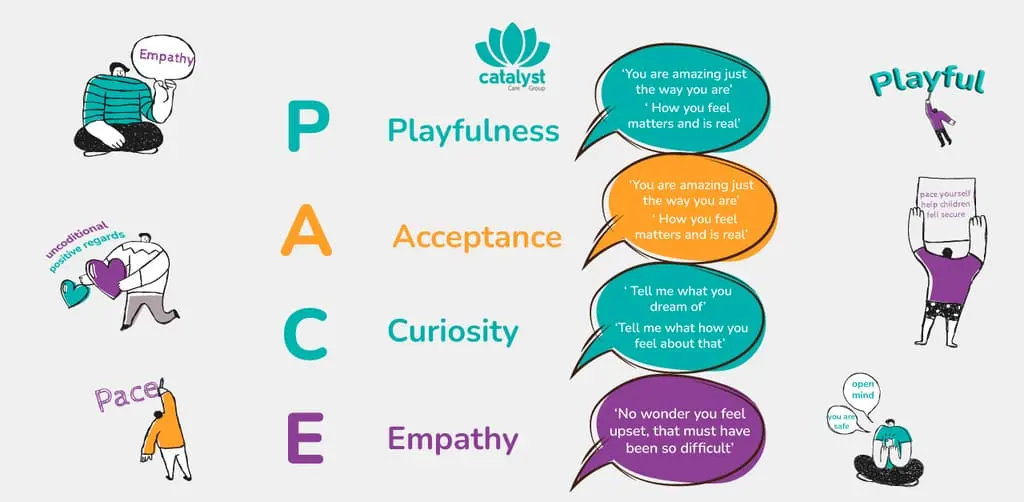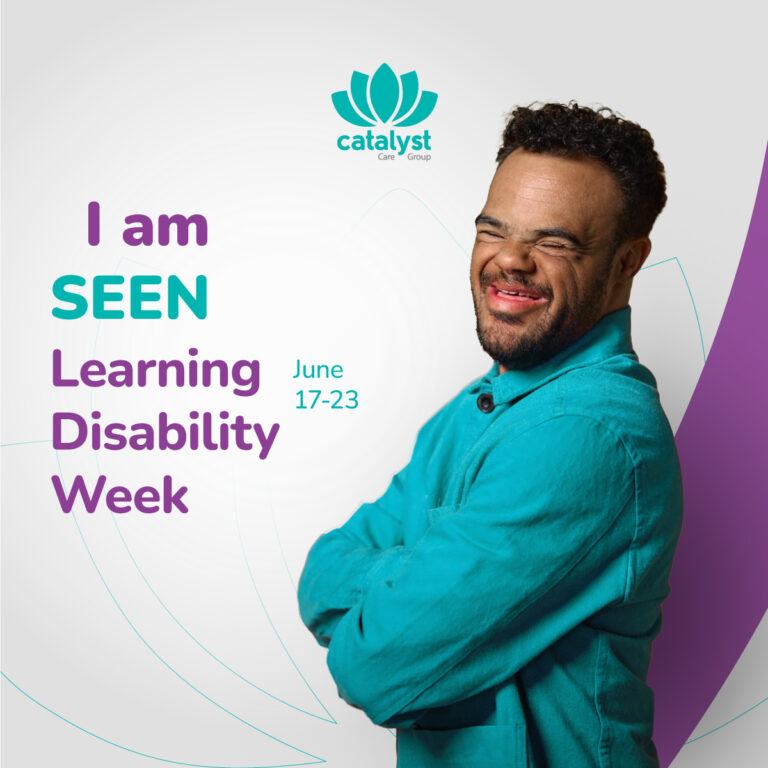The PACE model involves communicating and building safe, trusting and meaningful relationships with children and young people who have experienced trauma. PACE stands for Playfulness, Acceptance, Curiosity and Empathy. It’s a trauma-informed approach involving a way of thinking, communicating and behaving focused on making the child or young person feel safe and secure.

This is our chance to change the system. Join our White Paper Survey 2025!
In our experience, the PACE model is highly effective in meeting the needs of autistic children and young people as well as children and young people living with learning disability who have experienced trauma or attachment difficulties.
What Is PACE?
The PACE model is a psychological approach formed by clinical psychologist Dan Hughes. It’s centred on supporting children and young people recovering from developmental trauma. The model forms an essential part of attachment-focused family therapy, aimed at helping parents and caregivers build safe, trusting and genuine connections with children and young people with traumatic experiences.
The PACE approach teaches adults to reflect on their reactions, stay calm and learn what the child is experiencing. During challenging moments, it enables us to remain emotionally stable and guide the child through their intense emotions, thoughts, and behaviours. As a result, PACE helps children and young people feel more connected to and understood by the loved ones in their lives.

Why Is It Important?
Children and young people who have experienced a challenging beginning in life often perceive the world as unsafe and feel that people cannot be trusted to keep them secure. Without a sense of safety and security, they may struggle to focus on learning and exploring.
When we don’t feel safe, the body prepares to respond to danger. If the perceived threat is significant, the nervous system activates, increasing pain tolerance and often causing stillness. In this ‘freeze’ state, children may appear to zone out and exhibit confusing behaviours like inappropriate laughter that seems uncontrollable. This response is sometimes referred to as ‘dissociation’. When the perceived threat is less severe, the body prepares for defence, often called the ‘fight or flight’ response. Children who have experienced trauma can quickly escalate into this state, sometimes without a clear trigger or in response to a minor one.
Additionally, children who have experienced trauma are prone to experiencing ‘fight, fright, or flight’ reactions in everyday situations that wouldn’t usually cause fear. This reaction is unconscious, involuntary, and beyond their control. However, for children to be ready to learn and start the healing process, they need to be in a calm, open, and engaged state. Only in this state can they engage with others to understand and process events.
By actively communicating through the PACE approach, we can learn more about the child’s feelings and inner life and how to support them in healing. It also helps adults recognise the strengths and positive qualities of each child.
Let’s discuss each of the four key elements of the PACE model. The approach involves flexibly using the four elements of PACE together rather than following a strict step-by-step process.
Playfulness
A playful approach aims to elicit positive emotions and create moments of connection. It brings fun and laughter into relationships, allowing both the caregiver and the child to enjoy themselves while helping the child learn to experience and regulate positive emotions. Playfulness can engage the child at their developmental level and offer opportunities for play and learning that they may not have encountered before. It can also serve as a distraction and support a low-arousal method for managing behaviours.
Acceptance
Acceptance involves showing the child that you recognise and accept the wishes, feelings, thoughts, and motives behind their behaviour. This requires acknowledging and validating the child’s experiences, emotions, and perspectives without judgment. Acceptance communicates to the child that they deserve love and belonging, regardless of past experiences or challenges. It means seeing the child for who they are beyond their behaviour.
Curiosity
Curiosity encourages adults to engage with the child with genuine interest, aiming to understand their thoughts, feelings, and behaviours without making assumptions. This involves asking open-ended questions, actively listening, and seeking to understand the child on a deeper level, allowing support to be tailored to the child’s needs. Being curious is not about expecting a specific answer or gathering facts; it’s about getting to know the child and showing that this is the goal.
Examples of curiosity:
– “I’m thinking if you threw your teddy because you were upset?”
– “I’m wondering whether you might be slightly nervous about going to the market today, and that’s why you don’t want to get ready.”
Empathy
Empathy is crucial in helping children feel understood. When someone truly understands you, it can significantly impact how you cope. Being empathic is about being present and holding space for strong emotions. This creates a foundation for connection.
With empathy, when a child is sad or distressed, we share their sadness and distress and let them know that we understand how challenging the experience is for them. We communicate that they won’t have to face the distress alone and that we’ll get through it together. The adult stays emotionally present with the child, providing comfort and support, and doesn’t abandon them in their time of need.
Using the PACE Model in Practice
Using the PACE model in practice has helped our team members at Catalyst Care Group gain a much better understanding of children’s emotions, needs and their unique way of communicating. This therapeutic approach has proved to secure attachments in a child’s life, building a nurturing environment where children can thrive.
With an experienced team of Positive Behaviour Support (PBS) specialists, speech and language therapists and occupational therapists, we have witnessed remarkable results when implementing the following strengths-based models:
- PACE approach to trauma
- PERMA model of well-being
- PROACT SCIPr UK
- Trauma-informed support
- Restraint reduction strategies
To achieve the best possible outcome, we also work with an internal team of community psychiatric nurses (CPNs) who offer holistic and comprehensive care.
Benefits of The PACE Model
PACE takes a holistic approach and empowers children to be more confident around their family and support system and develop awareness about themselves, their thoughts, feelings and behaviour. The model also helps build the skills necessary for maintaining a successful and fulfilling life.
Children come to understand that they are doing their best and feel seen and valued. As a result, their difficulties or behaviours of concern decrease as the underlying need for them diminishes.
By feeling safer through PACE, children realise they can grow, develop and gain new skills. They learn to trust and rely on adults, including their parents, recognising that their caregivers truly understand and can care for them.
Positive Outcomes
To highlight positive outcomes with the PACE model, we have outlined the following key aspects:
- Enhanced Emotional Regulation
- Outcome: Children can better manage their emotions, reducing behaviours of concern and building emotional stability.
- Mechanism: The PACE model helps children and young people feel understood and validated by fostering a safe environment where emotions are acknowledged and accepted. This acceptance can reduce anxiety and promote emotional resilience.
- Improved Relationships and Social Skills
- Outcome: Stronger relationships with caregivers, peers, and others, leading to improved social interactions.
- Mechanism: Curiosity in the PACE model helps people develop a deeper understanding of themselves and others. This understanding fosters empathy and more effective communication, which are crucial for building and maintaining healthy relationships.
- Increased Self-Awareness and Self-Esteem
- Outcome: A greater sense of self-worth and confidence, leading to a more positive self-image and greater independence.
- Mechanism: The model encourages curiosity about one’s thoughts, feelings, and behaviours, which helps children and young people gain insight into their internal experiences. This self-awareness, coupled with the acceptance they receive, bolsters self-esteem and encourages them to explore their abilities and interests.
- Enhanced Coping Strategies
- Outcome: More adaptive coping mechanisms in the face of stress and challenges.
- Mechanism: By modelling and reinforcing positive ways of handling emotions and situations, the PACE model helps children and young people learn and practice healthy coping strategies. The playful aspect of the model can also make it easier to experiment with new behaviours and approaches in a non-threatening way.
- Increased Trust and Safety
- Outcome: A stronger sense of trust and safety in relationships, leading to more open and honest communication.
- Mechanism: Consistently responding with empathy, acceptance, and curiosity helps build a safe and trusting relationship. This trust is essential for people to feel comfortable expressing themselves and engaging in therapeutic processes.
- Promotion of Independence and Autonomy
- Outcome: Greater independence in managing daily life and making decisions.
- Mechanism: The model supports people in exploring their thoughts and feelings, leading to more autonomous decision-making. It encourages taking ownership of one’s actions and emotions, which is critical for developing a sense of agency and independence.
The PACE model’s emphasis on creating a supportive, empathetic, and non-judgmental environment leads to positive outcomes such as enhanced emotional regulation, improved relationships, increased self-awareness, better-coping strategies, and a stronger sense of trust and safety. These outcomes contribute to developing positive feelings and significantly improved quality of life.
Reducing the Need for Restrictive Practice
When children see adults making genuine efforts to understand them and collaboratively find better ways to manage their emotions, thoughts, and behaviours, they begin to trust that they will keep working to improve things for everyone involved.
In our practice, consistently using PACE has been shown to reduce negative emotions, defensiveness, and withdrawal, which are often prevalent in the lives of people who have experienced trauma or attachment challenges. PACE helps health and social care professionals recognise the strengths and positive qualities beneath the surface of behaviours of concern and truly understand the person’s emotions.
Implementation of PACE Model at Catalyst Care Group
As a family of organisations, we are committed to fully embracing a trauma-informed approach to care. Catalyst Care Group is defined by its emphasis on empathy and compassion, alongside our person-centered and outcome-focused strategies.
To foster a culture of excellence and ongoing improvement, we prioritise raising awareness about trauma-informed care and creating a supportive, inclusive environment. Our teams align with the core values and principles of the PACE approach, ensuring a safe emotional, psychological, and physical space for everyone to flourish.
For more details, explore our real-life impact stories or contact our managers.













